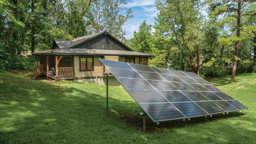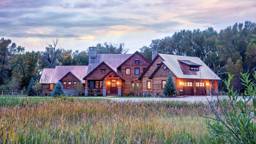
When Texas-based architect David Webber was commissioned to tackle the Chimney Corners remodel project in Austin, he was really hired to solve a problem that many existing homeowners face: I love the location of my home, but how do I update it to be a more modern and efficient? Fortunately, Webber and his team of experts at Webber + Studio come up with solutions for green remodeling for new and existing home projects every day.
Plus, the city of Austin has the oldest green-building program in the country, providing plenty of incentives from the local utility company, an abundance of green-building supplies and a five-star green rating system to help home improvers and their design and building teams set and achieve their green goals. So Webber got to work renovating a suburban home that wanted to shake its modest builder-style bones, all while becoming more sustainable, efficient and responsible. The result: A clean and contemporary remodel that still holds true to its ranch-style roots. But while the project shows just how successful (and beautiful) a green retrofit can be, it’s also a reminder that every potential remodeler needs to plan ahead before diving into the world of renovations. Here’s what you should keep in mind when planning yours.
When possible, plan ahead.
As Webber explains, when you’re working with an existing home, you’re really limited in what you can do. So if you know you’re going to purchase a house and then renovate it to make it more energy efficient, buy a good property to begin with. “If you know that you want to tackle a green remodel project, try to buy a home that’s already in really good shape and just needs some cosmetic updating. That way, you don’t have to worry so much about the infrastructure, but can make the home better through things like energy-efficient windows, green materials and appliances,” he says.
Also, suggests Webber, think twice before buying a historical home to renovate. “It turns out, a lot of the people that are really committed to sustainable design and construction are the same people that gravitate toward really old houses, but they don’t always make the best pairing. In order to make these older homes really sustainable while keeping them authentic-looking, you sometimes have to take things off just to put it all back on after you’ve improved the envelope. This can make things much more expensive and, frankly, a lot of old-house homeowners wind up running out of money before completing their total renovation project.”
Hire like-minded professionals.
It’s true; residential green architecture and building is a fairly new concept, but as Webber explains, it’s becoming easier to find credible people who are sensitive to and knowledgeable about green remodeling. “The most important thing is to get referrals and interview reputable people and pick who is best suited for you,” he says. “At the end of the day you’ll probably have to pick between a few great people and often it just comes down to chemistry and a gut feeling — who’s going to listen to you and give you exactly what you want.”
If you don’t live in a place brimming with green pros, you can find architects and builders accredited in Leadership in Energy and Environmental Design (LEED) by the US Green Building Council, a Washington, DC-based nonprofit that certifies green buildings, at usgbc.org. Also, web sites such as thebeam.com and moderngreenliving.com provide nationwide directories of green builders, designers and contractors, including their credentials and affiliations.
Do your research.
Just like any project, it’s important to approach your green remodel with as much knowledge about systems and materials as possible. Attend green house tours whenever possible; visit building supply stores to research things like Energy Star appliances, recycled materials and efficient windows and lighting; and make a call to your local utility company, which may offer information along with incentives and rebates (dsireusa.org, a Department of Energy-sponsored web site, provides state-by-state breakdowns of these). State and local government sites may also contain advice and links to resources. You might also want to attend a green building show, such as the US Green Building Council’s annual conference.
Put the envelope first.
If you don’t have the luxury of buying with your remodeling project in mind, take a look at your existing home and focus on the framing and structure first. “The envelope is where the performance really happens,” Webber explains. No matter your budget, your team should be able to find a way to improve the tightness and efficiency of your home, and then be creative with your money when thinking about things like finishes, appliances and decor.
Don’t worry too much about your choices.
Before getting to work to make your existing home greener, you’re going to have to decide just how green you want to be. If your goal is to create an energy-efficient house, you can focus on things like Energy Star appliances, on-demand water heaters, high-efficiency insulation and windows and solar technology. If you want to take it a step further, you might consider sustainably harvested woods, reclaimed materials, salvaged fixtures and rainwater collections.
But as you’re making your decisions, says Webber, don’t worry too much about each and every little detail. “Bottom line, if you’re building a quality home with quality materials, you’re most likely creating a sustainable and efficient structure without even having to try that hard. Just focus less on the size of the house and more on the quality, and you can’t go wrong.”











